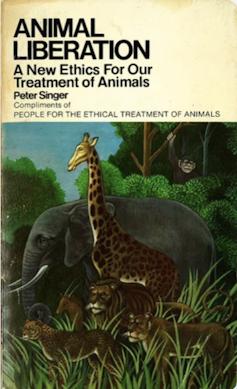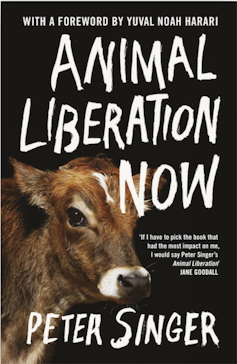Simon Coghlan, The University of Melbourne
In March, the ABC aired a story showing footage of pigs in Australian abattoirs being stunned with carbon dioxide before having their throats cut. Packed into small, gas-filled chambers, these animals could be viewed writhing, gasping and screaming in distress, some foaming at the mouth.
The pigs’ suffering was not an aberration; it is what countless pigs around the world commonly endure before being turned into ham and bacon. Such media exposés reveal how far we have – and have not – come since Australian philosopher Peter Singer published the seminal book Animal Liberation nearly 50 years ago.
Some features of this news story are testament to Animal Liberation’s influence on the animal rights movement, vegetarianism, and society generally. Like Ruth Harrison’s Animal Machines (1964), Singer’s book, first published in 1975, opened eyes to society’s almost endless exploitation of animals.
The footage of the gassed pigs used in the ABC story was obtained by a member of one of the many animal organisations that have emerged since Animal Liberation appeared. While such footage might once have been ignored, it made it to national prime-time television and was labelled “distressing” by Australia’s agriculture minister.
Animal Liberation, regarded as the “bible” of the animal rights movement, is one of Time magazine’s all-time top 100 non-fiction books.
Yet the revelations about the gassed pigs also illustrate the limits of Animal Liberation’s impact to date.
Some Australian states, like some other jurisdictions, recently enacted “ag-gag” laws to prevent activists filming farmed animals’ suffering. And while the aired footage caused horror, there was no promise to immediately halt the carbon dioxide stunning method – let alone to phase out industrial pig production.
A pork industry representative still felt able to admonish the activist for “putting stress on our animals”.
Animal Liberation Now: The Definitive Classic Renewed is an expanded, more comprehensive revision of Singer’s classic book. The title reflects his latest assessment of the state of animal rights.
Singer evinces some disappointment, especially concerning industrial farming. His call for a boycott of meat, he acknowledges, has been a “dismal failure”. Meat consumption is rising, including in newly developed economies. China, for example, is building “huge skyscraper ‘farms’” for millions of animals.
Despite this juggernaut, Singer retains some hope – so long as there are (as the book’s dedication reads) “many good people striving to bring about a better world for all sentient beings”.
Also underlying his cautious optimism is his belief that the book’s key ethical arguments, repeatedly tested over decades, are sound.
Modern treatment of animals
A key element of Singer’s strategy is to make the treatment of the animals we eat and perform research upon crystal clear. Many people remain unaware of the details. As in earlier editions, the two longest chapters of the updated book expose harmful uses of animals in scientific research and farming.
The numbers of sentient animals – that is, those capable of feeling and suffering –killed in science and agriculture are mind-boggling: hundreds of millions in research and billions to trillions (when fish are counted) in agriculture. Such numbers, along with animals’ often dire living conditions, prompt historian Yuval Noah Harari, in a preface to the book, to declare industrial farming “responsible for more pain and misery than all the wars of history put together”.
Some forms of animal treatment, Singer tells us, have improved somewhat. Certain countries began to better regulate animal research as the animal rights movement gained steam in the 1980s. In response to activism and changes in public sentiment, the European Union banned testing of cosmetics on animals, and the US National Institutes of Health ended its support for harmful research on chimpanzees.
In agriculture, animals like pigs, chickens, and veal calves now sometimes have slightly more room to move around in their cages due to consumer demand. Sow stalls, in which isolated pigs could barely move, were made illegal across the EU (but not in the US).
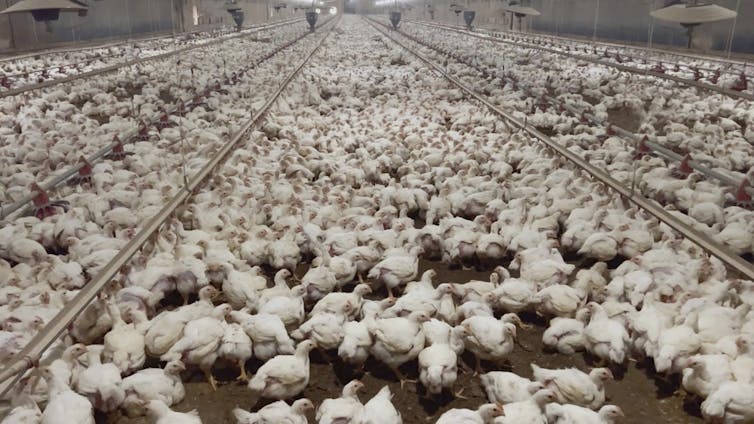
Yet since the book’s publication, a great deal has not improved for animals. Psychology experiments continued for decades to expose animals to severe deprivation, causing psychopathology, including self-destructive behaviour, aggression and extreme fear – even though such experiments have dubious application to humans.
While some animal experiments are justified in Singer’s view, the results of most experiments involving animals are never published or are not replicable. Pharmaceutical companies use animals to create “me too” drugs that do not offer significant advantages over existing medicines. Many guidelines for testing the safety of chemicals still require extensive animal testing. Some of these, such as new household cleaners, we could live without.
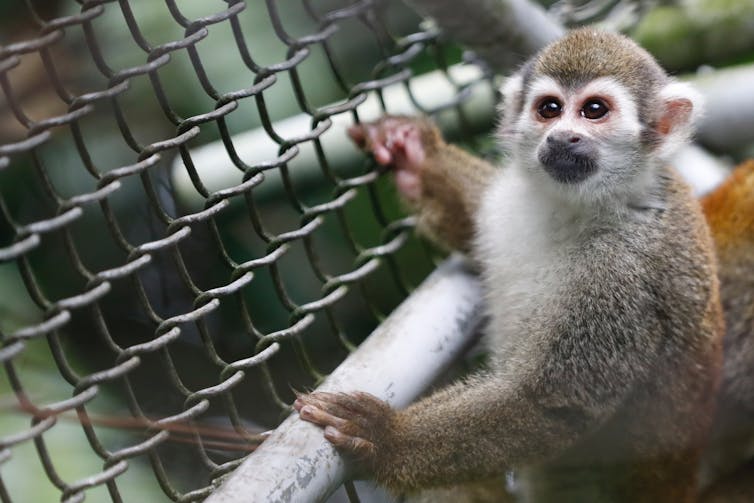
Most farmed animals are kept are out of sight in industrial factory systems. Intensively farmed species such as cows, pigs and chickens have been genetically altered so they suffer from conditions such as metabolic disturbance, lameness and hunger.
Sensitive body parts of factory-farmed pigs, birds and cattle are still cut off without anaesthetic, often to prevent animals harming one another from stress and boredom.
Many animals in abattoirs, Singer says, are likely butchered or dropped in boiling water while still conscious. During the COVID pandemic, US farmers and veterinarians “depopulated” countless pigs and chickens by deliberately heating them to death. Dairy cows are routinely separated from their calves, and cattle feedlots have expanded.
As Singer argues, such large-scale, profit-driven systems cannot treat animals humanely. Meanwhile, scientific research continues to show that animals, including farmed species, possess many mental capacities similar to those of humans. These capacities, as Charles Darwin recognised, include affection, grief, sympathy, memory, attention and curiosity.
The revised book extends the discussion of consciousness in animal species. For instance, recent science suggests animals such as some insects and decapods may have some sentience. Other exploited invertebrates, such as the octopus, show signs of an extraordinary “alien-like” intelligence. Singer even discusses scientific suggestions that plants may be minimally conscious, although he thinks this very unlikely.
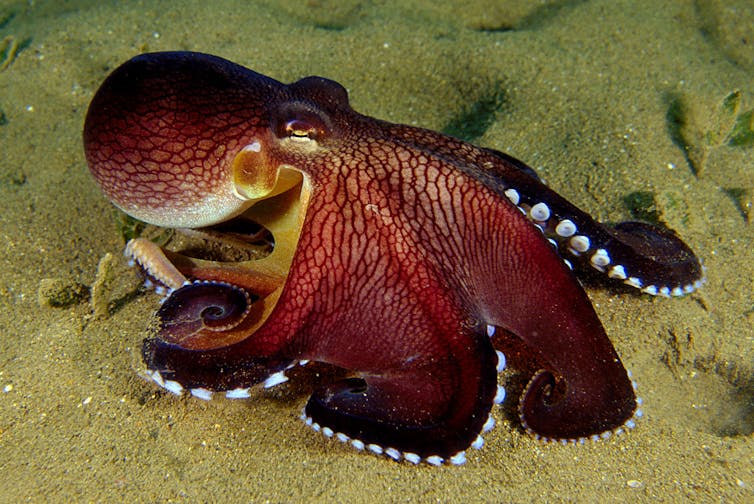
Species prejudice – Singer’s radical idea
Animal Liberation Now argues that non-humans in the 21st century continue to be treated in science and in farming essentially as tools or objects. For Singer, this strikingly illustrates the book’s central philosophical idea of “speciesism”, a term he popularised and endowed with philosophical sophistication.
Most humans, argues Singer, are speciesist. They assume it is acceptable to discriminate against non-human animals merely because they belong to a different species. Singer famously argues that speciesism is a prejudice akin to racism and sexism. Those prejudices involve discrimination by a dominant group against a weaker one based on morally arbitrary characteristics.
Society has lately made progress towards recognising that no-one may treat another’s interests as ethically less important simply because they are not, say, a white man. But equally, says Singer, we should not downgrade another’s interests merely because they are not biologically human. And we should not downgrade the comparable interests of species that are less “loved”, such as rodents.
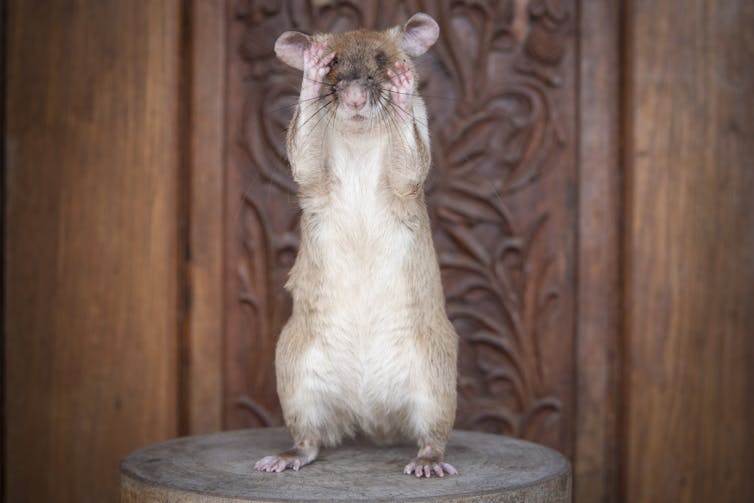
Rather, Singer argues, we should adopt a moral principle of equal consideration of interests, that applies regardless of species. If it is wrong to cause a human being to suffer, it should be equally wrong to cause a nonhuman animal to suffer to a similar extent.
Most people will baulk at the extension of the principle of equality across the species divide. But ethical arguments supporting human superiority, Singer replies, are weak. Consider the argument that humans are special because of capacities such as rationality or moral reasoning. Some humans who are severely cognitively impaired permanently lack these abilities. Yet obviously we believe that to “fatten them, kill them, and eat them” is morally outrageous. According to Singer, consistency demands extending the same attitude to non-humans with similar capacities.
Like the utilitarian philosopher Jeremy Bentham, Singer believes the key ethical question about animals is not “can they reason?” nor “can they talk?”, but “can they suffer?”
Philosophical disputes
Singer’s argument about speciesism is controversial. Many philosophers have come to accept it. But others believe there is something about simply being human that is special. Even so, Singer’s opponents have had difficulty undermining his position.
Philosopher Shelly Kagan recently argued that what distinguishes severely cognitively impaired humans from non-humans is that the former could have been “persons” were it not for conditions such as brain injury in infancy. Animals, by contrast, were never going to develop into “persons”.
Singer replies that some cognitively impaired humans with, say, severe genetic abnormalities were never going to be persons either. Moreover, why is the mere possibility that an individual could have been a “rational person”, even though they are not, morally relevant?
Singer also advances a kind of debunking argument against meat-eating, offering various psychological and cultural reasons to help explain why speciesism is so entrenched. The updated chapter on “Man’s Dominion” vividly exposes such forces.
Singer details how, in the West, Christianity repeatedly denigrated animals, notwithstanding the occasional apparent animal-friendly sentiment, including among recent popes. Philosophers such as Immanuel Kant and René Descartes joined in the denigration.
In all editions of the book, Singer has drawn attention to the strong vested interests that companies, governments and individuals have in meat production. We grow up in cultures that tell us food animals hardly matter.
Singer now reports on recent studies that reveal how we try to escape the psychological discomfort of eating sentient animals by, for example, reflexively denying that those animals have minds. He might also have mentioned recent work that links animal prejudice to bias against human “outgroups” – groups with whom a given person may not directly identify, such as immigrants.
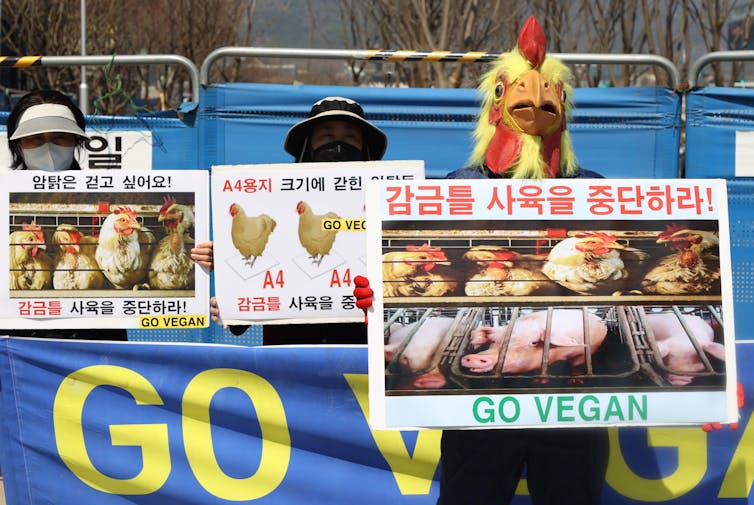
Lately, the ethical case against meat-eating has been buttressed by arguments about its environmental impact. Singer earlier pointed to pollution from factory farms. Now he can also point to the large contribution that animal agriculture, always a relatively inefficient way of producing food, makes to climate change.
Preventing forest destruction for beef farming, or opting to rewild farming land, may turn out to be necessary for preventing more extreme global warming. Abolishing factory farming may also limit future animal-originated pandemics.
Other objections
While Animal Liberation Now fortifies Singer’s earlier case, further objections will be forthcoming. Some animal advocates will be disconcerted that Singer, a utilitarian, theoretically approves of harmful animal experiments, albeit within narrow bounds. Although he opposes most current animal experimentation, Singer is open to condoning, for example, experiments on monkeys that substantially improve the lives of tens of thousands of people with Parkinson’s disease. Some advocates will feel that even these experiments violate animal rights.
They will also oppose the suggestion that killing animals for unnecessary food may be acceptable if the animals would otherwise not exist. However, Singer’s main aim here is to undermine speciesism, not to defend particular views on the ethics of killing or to argue for utilitarianism itself, as he does elsewhere.
Singer claims that a position like his, which appeals only to rational argument, is both sturdier and more persuasive than arguments that admit some role for human sensitivity. Some philosophers, however, deny that moral reason can be so radically distanced from feeling. Indeed, arguably part of the persuasive effect of Animal Liberation Now is the combination of careful logic and language that, although restrained, is not without feeling.
For example, Singer writes of how “wonderful” it is to see a “dejected, timid, almost featherless hen … recover both her feathers and her natural dignity” when removed from the barren cages. Some philosophers would argue that such responses are not unconnected to moral insight.
The compassion as well as the outrage and horror that Singer’s writing has elicited in readers over the years has surely contributed to Animal Liberation’s influence – including on some of those who reject Singer’s principle of equality for humans and non-humans.
The future for animals?
Singer gives little detail about what should become of species like sheep, pigs, chickens and cows after liberation. He does say that most laboratory cages will be empty and that pigs may roam freely.
Some animal advocates hope for the eventual extinction of these much-abused species, while others allow for mutually positive relations with humans, as seen on some farm-rescue sanctuaries.

Intriguingly, Singer appears to approve of several dairies, such as How Now dairy in Australia, that claim not to harm or kill their cows and to keep mothers with their calves. He now also discusses how we might address the vexed question of wild animal suffering.
Whatever its shape, what are the chances Singer’s vision will eventuate? Perhaps artificial intelligence and other technologies will help replace much animal experimentation. Maybe improvements in plant-based meat alternatives and cell-cultured meat will allow us to withdraw from the farming of sentient beings. We might then gain a more impartial ethical perspective on non-human animals.
In any case, Singer takes comfort from words attributed to the Indian revolutionary Mahatma Gandhi about genuine justice movements that have the courage to challenge entrenched interests: “First they ignore you. Then they laugh at you. Then they attack you. Then you win.”
If Singer is right, animal liberation may one day achieve the success of anti-slavery, anti-colonial, women’s and, increasingly, LGBTQI+ movements.
For those with an interest in culture, ethics and animals – and especially for those who have not read earlier editions of the book – Animal Liberation Now is essential reading.
Simon Coghlan, Senior Lecturer in Digital Ethics, Centre for AI and Digital Ethics, School of Computing and Information Systems, The University of Melbourne
This article is republished from The Conversation under a Creative Commons license. Read the original article.
Posted on:



